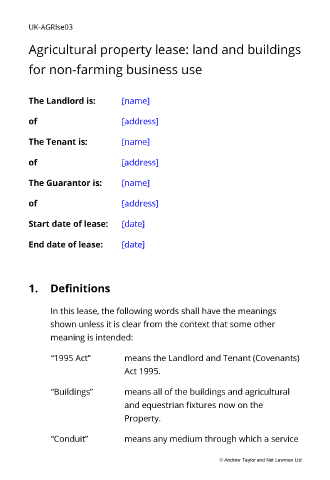Agricultural property lease

Document overview

 England & Wales
England & Wales Scotland
Scotland

- Length:15 pages (6300 words)
- Available in:
 Microsoft Word DOCX
Microsoft Word DOCX Apple Pages
Apple Pages RTF
RTF

If the document isn’t right for your circumstances for any reason, just tell us and we’ll refund you in full immediately.

We avoid legal terminology unless necessary. Plain English makes our documents easy to understand, easy to edit and more likely to be accepted.

You don’t need legal knowledge to use our documents. We explain what to edit and how in the guidance notes included at the end of the document.

Email us with questions about editing your document. Use our Lawyer Assist service if you’d like our legal team to check your document will do as you intend.

Our documents comply with the latest relevant law. Our lawyers regularly review how new law affects each document in our library.
About this document
This is a lease for agricultural land, perhaps with buildings, most likely to be fields, but possibly woodland or moorland.
The tenant may be a private individual using the land for recreational or storage purposes, but is more likely to be a business that is engaged in something other than “agricultural business”, for example, goods retail, machinery storage, a clay pigeon shooting centre, mountain bike rental, or a go-karting business.
The term of the lease should be for less than 7 years.
This agreement includes additional provisions relating to the upkeep of land that might be used for agriculture.
The law relating to this document
This document creates a lease under the Landlord and Tenant Act 1954. Account has also been taken of:
- The Landlord and Tenant (Covenants) Act 1995
- The Regulatory Reform Regulations 2003
In balancing the codes with the law and the interest of the landlord, we have followed the codes where reasonable, but have preferred the interest of the landlord where there may be a difference.
When to use this agreement
Land law is complicated, having been designed to protect tenants dependent on living from the land from owners who otherwise would have power to dictate terms of occupation. Using the wrong type of document has implications for a landlord on what a tenant may do and the ease with which a contract can be ended.
In disputes, the law is more likely to be applied to the circumstances of occupation rather than the title of the legal document.
This lease is likely to be suitable if:
- The term of the tenancy is between 6 months and 7 years
- The landlord is willing to give the tenant advance notice before accessing the property or ending the tenancy
- The tenant is not a farmer or anyone who will grow crops or breed animals with a view to sale
This lease should not be used if the tenant will live on the property (for example, in a caravan or in a building).
Alternatives to this lease
If the arrangement is simply that the use of the property is for grazing (and not for any other purpose such as recreational riding), a short term grazing agreement may be preferable to a lease.
If the property is used for a specific purpose for a short period of time, such as to hold a show or a three day eventing competition, then an licence agreement may be appropriate.
Contents
The tenant is limited to using the property as set out in the document. This gives the landlord greater control of what the tenant can do, and thus how the land will be looked after.
This lease is comprehensive and provides alternatives for important choices. It contains 27 provisions and 1 schedule, including:
- the lease
- rent: amount and frequency, other payments, interest, review
- condition and repair
- tenant’s positive obligations
- restrictions on the tenant
- agricultural provisions
- competitions, vehicles and grassland damage
- signs and advertisements
- goods and vehicles
- default notice by the landlord
- assignment of the lease
- subletting not allowed
- tenant indemnifies the landlord
- insurance
- security deposit
- access for the landlord
- guarantor
- provision for premature termination
- forfeiture
- security of tenure excluded
- schedule 1: rights reserved

Recent reviews
Choose the level of support you need
Document Only
This document
Detailed guidance notes explaining how to edit each paragraph
Lawyer Assist
This document
Detailed guidance notes explaining how to edit each paragraph
Unlimited email support - ask our legal team any question related to completing the document
- Review of your edited document by our legal team including:
- reporting on whether your changes comply with the law
- answering your questions about how to word a new clause or achieve an outcome
- checking that your use of defined terms is correct and consistent
- correcting spelling mistakes
- reformatting the document ready to sign
All rights reserved
